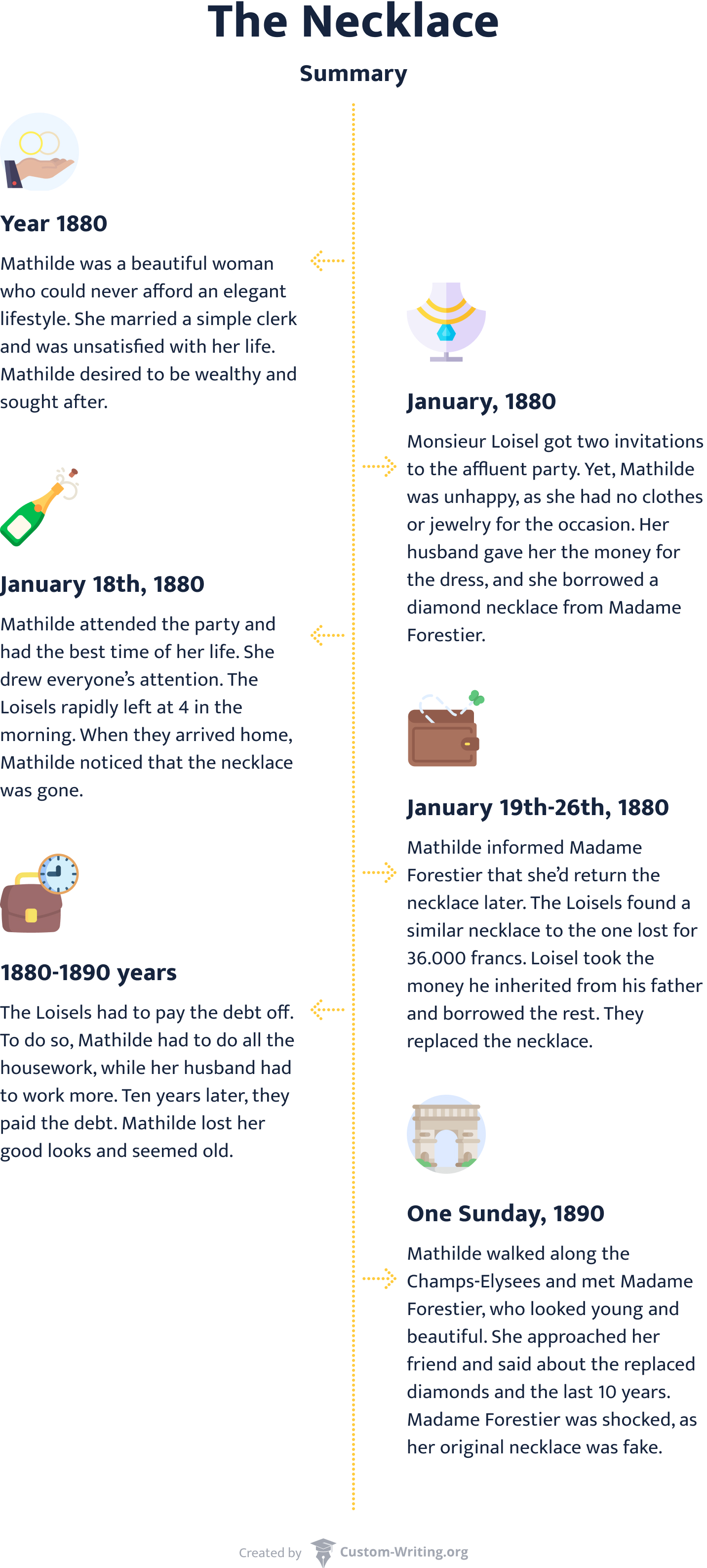The Necklace is an 1884 short story authored by Guy de Maupassant. In summary, it tells the tale of Mathilde Loisel, a woman born to a middle-class family who eagerly wishes to be wealthy. However, this desire to live beyond her means eventually leads her to tragic consequences. According to Florence Goyet’s 2014 analysis of The Necklace by Guy de Maupassant, the story is notable for its unexpected ending, which lays bare the truth behind the glamorous world of the rich.
This article, written by our custom writing team, contains:
- A short summary of The Necklace by Guy de Maupassant
- The visual timeline of the story
- The Necklace analysis with particular attention to its setting
- The humor and irony used in the story

The Necklace: Summary
The Necklace by Guy de Maupassant tells the reader about Mathilde Loisel, who desperately wished to marry a wealthy man. She ended up marrying Monsieur Loisel, a minor clerk in the Ministry of Public Instruction. The Necklace’s internal conflict is Madame Loisel’s embarrassment of poverty and the belief she’s worth more. She was dissatisfied with her life but has never seen anything better. Yet, she was convinced that her beauty and charm would guarantee her the wealthy lifestyle she dreamt of. Mathilde Loisel is spending her days dreaming about the incredible life she’s not having.
The rising action of The Necklace starts with an invitation. One day, Monsieur Loisel brings home an invitation to a ball hosted by his boss. He worked hard to obtain it and thought that his wife would be satisfied. However, Madame Loisel got upset with the fact she had nothing to wear. She asked her husband for 400 francs, and he hesitantly gave them to her. Yet, it wasn’t enough, and Mathilde threw another fit because she had no jewelry. Monsieur Loisel suggested she went to see Madame Forestier, who could kindly lend something. Mathilde chooses to borrow a gorgeous diamond necklace. She feels better from just looking at herself in the mirror with the jewels on her neck.
As the time of the ball arrives, Mathilde has the time of her life. Everyone admires her. Men wonder who she is. She spends the night dancing while her husband falls asleep in the other room. At 4 am, Madame Loisel rushes out into a street, so no one can see that she has no fancy fur coat. As they arrive home, Mathilde makes a sad discovery: the diamonds are gone. The loss of the necklace is the climax of the story.
They spend the next days and a week looking for a necklace. Yet, they find nothing. Mathilde writes to Madame Forestier that the necklace’s clasp is broken, and they have it fixed to buy them some time. However, the Loisels were at no luck. Therefore, they decided to buy a new necklace to replace the lost one. As they go to the jewelry store, they learn that it cost 36 thousand francs, twice the amount of money Monsieur Loisel has. The conflict of The Necklace is that to return the lost necklace, he goes into debt and buys it.
Now massively in debt, the Loisels have to change their lifestyle drastically. The falling action of the story covers the next ten years of hard work and poverty. The Loisels had to dismiss their servants and move out of their apartment. Mathilde, once dreaming about the rich life, now had to do all the housework herself. Also, she lost her beauty and charm. Now, she looked like the household’s rough woman, yet facing her part with unexpected heroism and patience. Ten years later, the debt was paid off.
One day, after a week of hard work, Mathilde decided to take a walk. During the walk, she encountered Madame Forestier, who remained young and charming. Mathilde was hesitant about approaching her, yet still did, even though Madame Forestier had a hard time recognizing her. Once she did, Mathilde told her about the financial situation.
Madame Loisel explains that to return the lost necklace, she and her husband had to buy a new diamond necklace. Due to this, they spent the last ten years paying the debt. Madame Forestier was shocked by the story. She said that her necklace was fake and cost five hundred francs at max.
The Necklace: Analysis
It’s not apparent in the summary of The Necklace by Guy de Maupassant, but the story’s exposition introduces the readers to the protagonist without telling her name. The twist is that she is no princess in the fairytale. She was born to a middle-class family and had little to no chances of living in the above this class.
The analysis of The Necklace shows that Maupassant focused on realism and naturalism. The author believed that fiction should be as realistic as possible. Therefore, the desire to report events as they were explains the setting of The Necklace. Realism took its start in mid-nineteenth-century France and rejected the basics of romanticism. Such works focused on describing people and their actions with little to no subjectivity.
The Necklace: Setting
The Necklace’s plot shows readers all middle-class life elements in the example of a woman fixated on non-existent wealth, Mathilde. The action takes place in Paris, which was full of couples struggling with their finances at the time. The settings of The Necklace are also used to establish the differences between Madame Loisel’s dull home and Madame Forestier’s more comfortable house.
Even the story’s tone is pessimistic and ironic to show the realms of nineteenth-century Paris’s life.
The author provides no reflection on the actions of the protagonist. Instead, he describes the events and desires of Mathilde as they were. In the end, there is no opinion or hidden message on what the meaning of the story The Necklace is. He reports the events.
The author’s choice of characters can also be explained by realism. At the end of the nineteenth century, Paris was full of middle-class families having a hard time getting by. Therefore, the situation described could happen to anyone there.
When looking at the marriage between the Loisels, the reader won’t find anything surprising. There is no great love between them, as well as no financial benefit.
Monsieur Loisel is attentive and tries to please his wife in possible ways. Madame Loisel, on the opposite, lives in daydreams, dissatisfied with her current life. Yet, when facing the need to pay the debt, they bravely spend years working for it.
Maupassant devoted several paragraphs to describe Mathilde early in the story. The protagonist appears to be an environment’s product, which shows a naturalistic approach to the characterization. Mathilde was dissatisfied with the financial situation of her family, yet always remained passive. The author showed that characters like her adapt to the circumstances rather than change them.
The Necklace: Humor
The analysis of The Necklace by Guy de Maupassant reveals it’s filled with humor. In general, it is a story based on situational irony. The term refers to the contradiction between the expectation of the reader and what happens. An example of situational irony is the limited value of the necklace. Moreover, the fact that upon the discovery of the loss, no one asked for its actual cost. Or that Madame Forestier decided not to share the information from the very beginning. In case the Loisels knew the price from the start, they wouldn’t have to give up their lives.
The twist of the plot, in the end, makes the reader see the story as a series of contradicting events. At first, Mathilde is the talk of the night. Then, she has almost nothing.
Until the end, some readers might interpret the protagonist’s poverty as a punishment for the night of pleasure and lost necklace. Yet, the ending reveals the dramatic irony: ten years of hard work were unnecessary. The horrible irony in The Necklace is that she spent years paying the debt for a worthless piece. What’s more ironic is that in the process of paying for something that wasn’t worth it, she lost something more important to her—her beauty. She borrowed the necklace to look more stunning but eventually lost her looks completely.
The Necklace shows the bitter irony of Mathilde’s thoughts. The conditions in which she lived, in the end, make her old life seem luxurious for her. She borrowed the necklace to look more wealthy than she is. In the end, she pays with money and her good looks. The resolution of The Necklace is Mathilde’s confession to Madame Forestier about the lost jewels. To add more, she spent years paying for something that had little value from the start.
The rhythm of the story guides the readers’ expectations about the ending. At the start, Mathilde is dissatisfied with her current life. Then, she gets invited to a ball that is the possibility to change something. Yet, the events leading to the reception only show her dissatisfaction with everything. A line of unfortunate events shows that whenever Mathilde gets whatever she wants, she remains unfulfilled. However, the time after a ball is more than a mere dissatisfaction. It is a catastrophe for her life.
Thanks for reading our analysis! We hope The Necklace’s summary and examination were helpful to generate a topic for a paper. Or you can check the essay ideas and samples to write an analysis on the short story yourself.
🔗 References
- Ending with a Twist: Florence Goyet
- The Diamond Necklace by Guy de Maupassant: The Project Gutenberg
- Text to Text | Guy de Maupassant’s ‘The Necklace’ and ‘Guerrilla Fashion: The Story of Supreme’: The New York Times
- The Main Character Analysis in “The Diamond Necklace” by Guy De Maupassant: ResearchGate












What is God never mentioned in the story?
It’s so good with depth in analysis, thank you